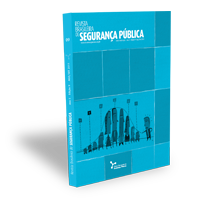Evidências de validade e precisão da escala de atitudes frente à Polícia
DOI:
https://doi.org/10.31060/rbsp.2011.v5.n2.96Palavras-chave:
Atitudes frente à Polícia, Validade, PrecisãoResumo
Numa sociedade repleta de crimes, é fundamental uma Polícia atuante, assim como pesquisas sobre as atitudes frentea esta instituição. No entanto, pouco se encontrou no contexto da psicologia nacional sobre a construção e validaçãode uma escala de atitudes diante da Polícia. Neste artigo se propõe tal medida para suprir esta lacuna. Os principaisresultados foram obtidos por meio da análise fatorial confirmatória, que corroborou a estrutura unifatorial da medida,que era prevista. O coeficiente de confiabilidade (alfa de Cronbach) demonstrou elevada precisão da medida. Não severificaram, ademais, efeitos do sexo nas atitudes em relação à Polícia, controlando-se a idade. As evidências favoráveisde validade e precisão desta medida são discutidas.Downloads
Referências
ADAMS, K. Measuring the prevalence of police abuse of force”. In: GELLER, W.; TOCH, H. Police violence: understanding and controlling police abuse of force. New Haven, CT: Yale University Press, 1996, p. 52-93.
ADAMS, R. E; ROHE, W. M.; ARCURY, T. A. Awareness of community oriented policing and neighborhood perceptions in five small to midsize cities. Journal of Criminal Justice,v. 33, n. 1, p. 43-54, 2005.
AJZEN, I. The theory of planned behavior. Organizational Behavior and Human Decision Processes,n. 50, p. 179-211, 1991.
ALBARRACÍN, D.; ZANNA, M. P.; JOHNSON, B. T.; KUMKALE, G. T. Attitudes: introduction and scope. In: ALBARRACÍN, D.; JOHNSON, B. T.; ZANNA, M. P. (Eds.). The hand book of attitudes. London: Laurence Erlbaum Associates, Publishers, 2005, p. 3-21.
ALLPORT, G. W. Attitudes in the history of social psychology. In: WARREN, N.; JAHODA, M. (Eds.). Attitudes. London: Penguin Books, 1966, p. 15-21.
AREH, I.; DOBOVS ˇEK, B.; UMEK, P. Citizens’ opinions of police procedures. Policing: an International Journal of Police Strategies & Management, v. 30, n. 4, p. 637-650, 2007.
BAYLEY, D. Padrões de policiamento. Tradução de R. A. Belmonte. . São Paulo: Edusp, 2001.
BOBO, L.; JOHNSON, D. A taste for punishment: Black and white americans’ views on the death penalty and the war on drugs. Du Bois Review,n.1, p. 151-80, 2004.
BORRERO, M. The widening mistrust between youth and police. Families and Society: the Journal of Contemporary Human Services, v. 82, n. 1, p. 399-408, 2001.
BRANDT, D. E.; MARKUS, K. A. Adolescent attitudes towards the police: a new generation. Journal of Police and Criminal Psychology, v.15, n. 1, p. 10-16, 2000.
BRICK, B. T.; TAYLOR, T. J.; ASBENSEN, F. A. Juvenile attitudes towards the police: the importance of subcultural involvement and community ties. Journal of Criminal Justice,v. 37, n. 5, p. 488-495, 2009.
BROWN, B.; BENEDICT, W. R. (Perceptions of the police: past findings, methodological issues, conceptual issues, and policy implications. Policing: an International Journal of Police Strategies and Management, v. 25, n. 3, p. 543-580, 2002.
BROWNE, M. W.; CUDECK, R. Alternative ways of assessing model fit. In: BOLLEN, K. A.; LONG, J. S. (Eds.). Testing structural equation models. Newbury Park, CA: Sage, 1993, p. 136-162.
BYRNE, B. M. (Structural equation modeling with AMOS: basic concepts, applications, and programming. Mahwah: Lawrence Erlbaum Associates, 2001.
BYRNE, B. M. Structural equation modeling with AMOS: basic concepts, applications, and programming. New York: Routledge, Taylor and Francis Group, 2010.
CARTER, D. L. Hispanic perception of police performance: an empirical assessment. Journal of Criminal Justice, v. 13, n. 6, p. 485-500, 1985.
CLARK, A. C.; & WATSON, D. Constructing validity: basic issues in objective scale development. Psychological Assessment, n. 7, p. 309-319, 1995.
CRITES, S. L.; FABRIGAR, L. R.; PETTY, R. E. Measuring the affective and cognitive properties of attitudes: conceptual and methodological issues. Personality and Social Psychology Bulletin, v. 20, n. 6, p. 619-634, 1994.
DAVIS, R. C.; MATEU GELABERTH. Policiamento eficiente e com respeito: dois exemplos no South Bronx. Relatório de pesquisa do Vera Institute of Justice. New York, 1999.
DECKER, S. Citizen attitudes toward the police: a review of the past findings and suggestions for future policy. Journal of Police Science and Administration, v. 9, n. 1, p. 80-87, 1981.
EAGLY, A. H.; CHAIKEN, S. The psychology of attitudes. Orlando, FL: Harcourt Brace Jovanovich, 1993.
FARLEY, J. U.; LEHMANN, D. R.; RYAN, M. J. Generalizing from “imperfect” replication. Journal of Business, n. 54, p. 597–610, 1981.
FAZIO, R. H.; SANBONMATSU, D. M.; POWELL, M. C.; KARDES, F. R. On the automatic activation of attitudes. Journal of Personality and Social Psychology, n. 50, p. 229-238, 1986.
FERREIRA, D. C. S.; PIMENTEL, C. E.; CIRINO, C. S.; SANTOS, H. S.; OLIVEIRA, M. C. Psicologia da era virtual: atitudes de estudantes adolescentes frente ao Orkut. Psicologia Argumento, v. 26, n. 55, p. 305-317, 2008.
FISHBEIN, M.; AJZEN, I. Belief, attitude, intention, and behavior: an introduction to theory and research. Reading, MA: Addison Wesley, 1975.
FLANAGAN, C.; SHERROD, L. (Youth political development. Journal of Social Issues, v. 54, n. 1, p. 447-56, 1998.
FLANAGAN, T.; VAUGHN, M. Public opinion about police abuse and force. In: GELLER, W.; TOCH, H. Police violence: understanding and controlling police abuse of force. New Haven, CT: Yale University Press, 1996, p. 113-128.
FRIEDMAN, W.; LURIGIO, A. J.; GREENLEAF, R. G.; ALBERTSON, S. Encounters between police and youth. Social Costs of Disrespect,v. 27, n. 1, p. 1-25, 2004.
GLASMAM, L. R.; ALBARRACÍN, D. Forming attitudes that predict future behavior: a meta-analysis of the attitude-behavior relation. Psychological Bulletin, v. 13, n. 5, p. 778-822, 2006.
GOUVEIA, V. V.; PIMENTEL, C. E.; LEITE, P. R. L.; ALBUQUERQUE, J. R.; COSTA, T. A. B. Escala de atitudes frente ao uso de álcool: evidências de validade fatorial e preditiva. Psicologia Ciência e Profissão, v. 29, n. 4, p. 672-685, 2009.
GOUVEIA, V. V.; PIMENTEL, C. E.; MEDEIROS, E. D.; GOUVEIA, R. S.; PALMEIRA, J. N. (Escala de atitudes frente ao uso de drogas: evidências de validade fatorial e preditiva.Jornal Brasileiro de Psiquiatria, v. 56, n. 1, p. 53-59, 2007.
GOUVEIA, V. V.; PIMENTEL, C. E.; QUEIROGA, F.; MEIRA, M.; JESUS, G. R. Escala de atitudes frente ao uso de maconha: comprovação da sua validade de construto. Jornal Brasileiro de Psiquiatria, v. 54, n. 1, p. 5-12, 2005.
HAYTON, J. C.; ALLEN, D. G.; SCARPELLO, V. Factor retention decisions in exploratory factor analysis: a tutorial on parallel analysis. Organizational Research Methods, n. 7, p. 191-205, 2004.
HU, L. T.; BENTLER, P. M. Cutoff criteria for fit indexes in covariance structure analysis: Conventional criteria versus new alternatives. Structural Equation Modeling, n. 6, p. 1–55, 1999.
HURST, Y.; FRANK, J. How kids view cops: the nature of juvenile attitudes toward the police. Journal of Criminal Justice, v. 28, n. 3, p. 165-260, 2000.
KLINE, R. B. Principles and practice of structural equation modeling. New York: The Guilford Press, 2010.
KRAUS, S. J. Attitudes and the prediction of behavior: a meta analysis of the empirical literature. Personality and Social Psychology Bulletin,n. 21, p. 58-75, 1995.
KROSNICK, J. A.; JUDD, C. M.; WITTENBRINK, B. The measurement of attitudes. In: ALBARRACÍN, D.; JOHNSON, B. T.; ZANNA, M. P. (Eds.). The handbook of attitudes. London: Laurence Erlbaum Associates, Publishers, 2005, p. 21-76.
LEDESMA, R.; IBAÑEZ, G.M.; MORA, P. V. Análisis de consistência interna mediante Alfa de Cronbach: un programa basado en gráficos dinâmicos. Psico USF, v. 7, n. 2, p. 143-152, 2002.
MCDONALD, R. P.; RO, M.H. R. Principles and practice in reporting structural equation analyses. Psychological Methods, v. 7, n. 1: 64-82, 2002.
NIEMI, R.; HEPBURN, M. The rebirth of political socialization. Perspectives on Political Science, v. 24, n. 1, p. 7-16, 1995.
NUNNALLY, J. C. Psychometric theory. New York: McGraw Hill, 1978.
OLSON, M. A.; FAZIO, R. H. Implicit and explicit measures of attitudes: the perspective of the MODE model. In: PETTY, R. E.; FAZIO, R. H.; BRIÑOL, P. (Eds.). Attitudes: insights from the new implicit measures. New York, NY: Psychology Press, 2009, p. 19-63.
OSKAMP, S.; SCHULTZ, W. P. Attitudes and opinions.London: Laurence Erlbaum Associates, Publishers, 2005.
PASQUALI, L. (Psicometria: teoria dos testes na psicologia e educação. Petrópolis, RJ: Vozes, 2003.
PERIÓDICOS ELETRÔNICOS DE PSICOLOGIA – PePSIC. Atitudes frente à Polícia. 2011.
PERIÓDICOS ELETRÔNICOS DE PSICOLOGIA – PePSIC. Escala de atitudes frente à Polícia. 2011.
RAMOS, F. P.; NOVO, H. A. Representações sociais de governo, justiça e Polícia: um estudo nas camadas média e popular da Grande Vitória/ES. Psicologia: Teoria e Prática,v. 4, n. 1, p. 29-37, 2002.
REISIG, M. D.; MICHAEL, C. Public evaluation of police performance: an analysis across three levels of policing. Policing: An International Journal of Police Strategies and Management,v. 20, n. 1, p. 311-325, 1997.
REN, L.; CAO, L.; LOVRICH, N.; GAFFNEY, M. Linking confidence in the police with the performance of the police: community policing can make a difference. Journal of Criminal Justice, v. 33, n. 1, p. 55-66, 2005.
SCIENTIFIC ELECTRONIC LIBRARY ONLINE – SciELO. Atitudes frente à Polícia. 2011.
SCIENTIFIC ELECTRONIC LIBRARY ONLINE – SciELO. Escala de atitudes frente à Polícia. 2011.
SHERIFF, M.; CANTRIL, H. The psychology of “attitudes”: I. The Psychological Review, v. 52, n. 6, p. 295-319, 1945.
SIMONS, J.; CAREY, K. B. Attitudes toward marijuana use and drug-free experience: Relationships with behavior. Addictive Behaviors, v. 25, n. 3, p. 323-31, 2000.
SIMONS, J. S.; GAHER, R. M. Attitudes toward alcohol and drug-free experience among college students: Relationships with alcohol consumption and problems. American Journal of Drug and Alcohol Abuse, v. 31, n. 2, p. 337-56, 2004.
TABACHNICK, B. G.; FIDELL, L. S. Using multivariate statistics. Needham Heights, MA: Allyn & Bacon, 2007.
THOMPSON, B. Exploratory and confirmatory factor analysis. Understanding concepts and applications.Washington: American Psychological Association, 2005.
WALLACE, D. S.; PAULSON, R. M.; LORD, C. G.; BOND Jr., C. F. Which behaviors do attitudes predict? Meta analyzing the effects of social pressure and perceived difficulty. Review of General Psychology, n. 9, p. 214–227, 2005.
Downloads
Publicado
Como Citar
Edição
Seção
Licença
Copyright (c) 2012 Revista Brasileira de Segurança Pública

Este trabalho está licenciado sob uma licença Creative Commons Attribution 4.0 International License.
Licenciamento
A Revista Brasileira de Segurança Pública usa a Licença Creative Commons como forma de licenciamento para suas obras publicadas. A licença utilizada segue o modelo CC BY 4.0 - Attribution 4.0 International.
Para consultar os dirietos permitidos direcione-se para a licença completa ou para a nossa página de Direitos dos autores e Licenças.



